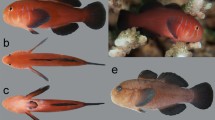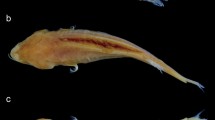Abstract
Obliquogobius trifasciatus sp. nov. (Teleostei: Gobiidae) is described on the basis of three specimens (29.5–30.5 mm in standard length) collected in the East China Sea, northwest of the Ryukyu Islands, southern Japan, in a depth of 115–124 m. The new species is characterized by the following combination of characters: 2nd dorsal and anal fins each with I, 9 rays; head moderate in size, its length 32.8–34.1% of standard length; lateral surface of nape scaled; postorbital pore G of cephalic sensory canal present; gill opening moderate in size, extending anteriorly to level with posterior margin of eye; pelvic fins united medially, with a well-developed connecting membrane (between innermost rays) and frenum (between spines); caudal fin dorsoventrally asymmetrical, lacking a distinct obliquely pointed tip, and with three lowermost branched rays much shorter than other branched rays; three broad black (dark brown in preserved specimens) bands, superposed by yellow chromatophores, on lateral surface of body, anteriormost band located under 1st dorsal-fin base, middle band just behind a vertical line through posterior end of 2nd dorsal-fin base, and posteriormost band on caudal-fin base; a small faint, yellow-tinged dusky blotch on center of caudal peduncle (between middle and posteriormost bands on body); a large black blotch, covering almost entirety of 1st dorsal fin; 2nd dorsal and caudal fins generally pale yellow, without a barred pattern.




Similar content being viewed by others
References
Akihito (1984) Suborder Gobioidei. In: Masuda H, Amaoka K, Araga C, Uyeno T, Yoshino T (eds) The Fishes of the Japanese Archipelago. English text. Tokai University Press, Tokyo, pp 236–238
Alcock AW (1890) On the bathybial fishes collected in the Bay of Bengal during the season 1889–1890. Ann Mag Nat Hist 6:197–222
Chen I-S, Jaafar Z, Shao K-T (2012) A new Obliquogobius Koumans, 1941 (Teleostei: Gobiidae) from Kumejima, Ryukyu Islands, Japan. Zootaxa 3367:269–273
Fricke R (2022) Obliquogobius bathyalis, a new species of deep-living gobies (Teleostei: Gobiidae) from New Caledonia, southwestern Pacific Ocean. FishTaxa 24:1–9
Fujiwara K, Psomadakis PN, Swe TYY, Motomura H (2021) Description of a new species of Obliquogobius (Teleostei: Gobiidae) from the Andaman Sea (northeastern Indian Ocean). Raffles Bull Zool 69:541–547
Goren M (1992) Obliquogobius turkayi, a new species of gobiid fish from the deep water of the central Red Sea. Senckenberg Maritima 22:265–270
Koumans FP (1941) Gobioid fishes of India. Mem Indian Mus 13:205–329
Sanzo L (1911) Distribuzione delle papille cutanee (organi ciatiformi) e suo valore sistematico nei gobi. Mitt Zool Stn Neapel 20:249–328
Saruwatari T, Lopez JA, Pietsch TW (1997) Cyanine Blue: a versatile and harmless stain for specimen observation. Copeia 1997:840–841
Shibukawa K, Aonuma Y (2007) Three new species of the deep-dwelling goby genus Obliquogobius (Perciformes: Gobiidae: Gobiinae) from Japan, with comments on the limits of the genus. Bull Nat Mus Nat Sci Ser A Suppl 1:137–152
Acknowledgments
We are most grateful to H. Motomura (KAUM) for providing the opportunity to examine the specimens, G. Shinohara, M. Nakae, Y. Inoue, S. Manaka, and H. Akutsu (NSMT) for their curatorial assistance, and G. Hardy (Ngunguru, New Zealand) for reading the manuscript and providing help with English. This study was supported in part by a Grant-in-Aid from the Japan Society for the Promotion of Science for JSPS Fellows (PD: 22J01404).
Author information
Authors and Affiliations
Corresponding author
Ethics declarations
Partial financial support was received from the Japan Society for the Promotion of Science, Tokyo, to KF. KF was responsible for the study design, analysis of the data, funding acquisition, and wrote the original draft manuscript. KS was responsible for analysis of the data and review of the manuscript. Both authors read the manuscript and approved the final version. The datasets generated during and/or analyzed during the current study are available from the corresponding author on request.
Conflicts of interest
This paper has no conflict of interest.
Ethics approval
Fish species, treated in this study, are not listed as threatened or endangered by the IUCN Red List or CITES. Specimens used in this study were collected following the national and institutional guidelines and registered in fish collections of natural history museums.
Additional information
Publisher's Note
Springer Nature remains neutral with regard to jurisdictional claims in published maps and institutional affiliations.
This article was registered in the Official Register of Zoological Nomenclature (ZooBank) as 9A1F5D24-CDA4-44D0-AC46-055F392A4C6E.
This article was published as an Online First article on the online publication date shown on this page. The article should be cited by using the doi number.
Supplementary Information
Below is the link to the electronic supplementary material.
About this article
Cite this article
Fujiwara, K., Shibukawa, K. Description of a new species of Obliquogobius (Gobiidae: Gobiinae) from the East China Sea off the Ryukyu Islands, southern Japan. Ichthyol Res 70, 431–438 (2023). https://doi.org/10.1007/s10228-022-00901-1
Received:
Revised:
Accepted:
Published:
Issue Date:
DOI: https://doi.org/10.1007/s10228-022-00901-1




